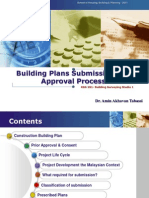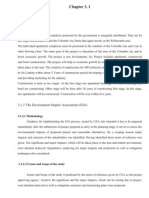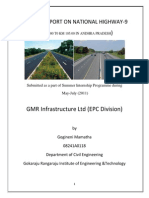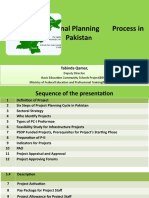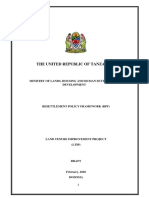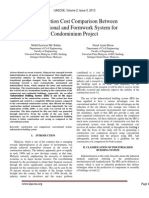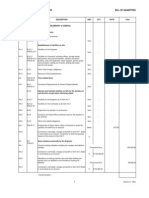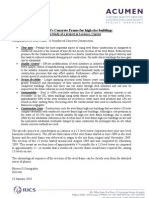Planning Process of Development Project in The Malaysian Context: A Crucial Brief Overview
Planning Process of Development Project in The Malaysian Context: A Crucial Brief Overview
Uploaded by
mrlobboCopyright:
Available Formats
Planning Process of Development Project in The Malaysian Context: A Crucial Brief Overview
Planning Process of Development Project in The Malaysian Context: A Crucial Brief Overview
Uploaded by
mrlobboOriginal Title
Copyright
Available Formats
Share this document
Did you find this document useful?
Is this content inappropriate?
Copyright:
Available Formats
Planning Process of Development Project in The Malaysian Context: A Crucial Brief Overview
Planning Process of Development Project in The Malaysian Context: A Crucial Brief Overview
Uploaded by
mrlobboCopyright:
Available Formats
International Journal of Applied Science and Technology
Vol. 1 No. 2; April 2011
Planning Process of Development Project in the Malaysian Context: A Crucial Brief Overview
Abdul Aziz Abdullah Faculty of Business Management and Accountancy, Universiti Sultan Zainal Abidin Gong Badak Campus, 21300 Kuala Terengganu Terengganu, Malaysia E-mail: abdulazizum@gmail.com Zakaria Harun Department of Civil Engineering, Faculty of Engineering University of Malaya, 50603 Kuala Lumpur Malaysia E-mail: zakariaharun@um.edu.my Hamzah Abdul Rahman Deputy Vice Chancellor, Research and Innovation University of Malaya, 50603 Kuala Lumpur Malaysia E-mail: arhamzah1@gmail.com Abstract
Successful development project is crucial to all project stakeholders. Meeting the dateline to complete a project will be an added advantage for both the developer and the land owner. Project development just like construction project will encounter some form of project life cycle (PLC). A typical PLC of developmental project comprise of a initiation and planning phase, construction phase and post construction phase. Further, the implementation of the one-stop-centre (OSC) by Ministry of Housing and Local Government (MHLG) nationwide in April 2007 have succesfully improved the delivery system of the planning process. As the result of the MHLG bold step, a more systematic planning process have benefited the developers, consultant and the authorities. In lieu of this, it is imperative that all the consultants and the developer should comply to the guidelines, rules and regulations stipulated in the standard manual drawn by Department of Town and Country Planning (DTCP) and the MHLG to ascertain a smoother planning approval process. Thus, in long run, all these moves implemented by the government should attract more foreign direct investment (FDI).
Key words: Development project, planning process Introduction
The success of a development project as a whole is crucial to all the stakeholders who primarily are the developer, the land owner and property buyer. The timely completion of a project that is not only within the budget but also in accordance to specifications and the stakeholders satisfaction (Nguyen et al., 2004) benefits both the project owner (developer) and the property buyer. Each and every project development will undergo some form of project life cycle (PLC) as mentioned by Kerzner (2009); PMI (2004). A typical developmental process comprise of a initiation and planning (predevelopment) stage, a intermediate stage (construction) (intermediate) and a closer stage (post development).
Project Development the Malaysian Context: A crucial brief overview
In the Malaysian context project development similarly has its own PLC which is divided into three (3) stages, namely, the predevelopment stage, the construction stage and the post construction stage. The close of a development project or the post developmental stage is when the completed property is handed over to the owner as required and stipulated by the Housing Development Act (HDA, 2010). The flow of activities starting from the inception right up to the delivery of a completed property plays a pivotal role in the planning of property development. A crucial brief overview of a typical planning process in Malaysia, covering the legislature in the planning process, the development plan and general implementation of development plan, and are as follows. 74
Centre for Promoting Ideas, USA
www.ijastnet .com
Legislature in the planning process
The laws, procedures and guidelines pertaining to the property development process in Malaysia are quite extensive. There are over fifty (50) laws and guidelines that may either be initiated or pose a constrain on decisions when undertaking a property development project. Those most pertinent and crucial laws to be complied to include the National Land Code (NLC) 1965 (NLC, 2008), the Town and Country Planning Act, 1976 (Act 172), the Government Act 1976 (Act 171), Uniform Building By Law 1984 (UBBL), the Street, Drainage and Building Act 1974 (Act 133) and the Environmental Quality Act 1984. A very important tool used to manage land development is planning control, referred to in Part IV of the Town and Country Planning Act (TCPA), 1976 and planning guidelines. In Section 19, the TCPA states that no person, other than the local authorities, shall, commence, undertake, or carry out any development unless planning permission in respect of the development has been granted to him under Section 22 (treatment of application or extended under Subsection 24 (3) (lapse of planning permission) (LOM, 2006).
Development plan
Various development plans (that is, the national physical plan; a structure plan, a local plan and a special area plan) has been formulated under Part III of the TCPA (TCPA, 1976) in order to guide the decision makers when processing planning permissions. These plans shall form the overall policies for future land development as well as used to establish zoning and planning standards concerning public facilities requirements, roads, open spaces, building setbacks, number of car parks etc. Basically, a layout plan that has been submitted must comply with the national and physical plan, the state structure plan, the local plan, a special area plan and all plans approved by the local authorities of the governing state. The submitting party is also required to comply with a pre-determined zoning requirement, strategic policies and government policies. For example, in the state of Selangor, any development on a piece of land that has been classified as class 3 and class 4 terrain, will not be approved for development by the respective local authority. Similarly, when it involves a composition of low cost, medium to low cost and medium cost housing and a specific race (that is Bumiputera or indigenous group) quota, the planner must prepare a layout plan that takes into consideration government policies, guidelines and other technical requirements.
General implementation of a development plan
A development plan in Malaysia is implemented within the framework provided under the National Development Planning that comes under the Town and Country Planning Act, 1976 (Act 172). The National Development Planning Framework (NDPF) comprises of three (3) levels of planning (Figure 2.1), namely the National Physical Council (NPC) at the Federal level, the State Planning Committee (SPC) at the state level and the local council at the local authorities level. The NDPF is implemented 'top-down' starting at the federal level down to the state level and finally to the local authorities level, directed towards achieveing a national development vision by the year 2020. Any development involving land that is more than 100 hectares in size requires initial approval from both the SPC and the NPC. The NPC is chaired by the Prime Minister while the SPC is chaired by the Chief Minister of the respective state of Malaysia. An approval by the state government is required prior to submission for approval to the NPPC for federal government approval. Both the NPPC and SPC convene twice a year to discuss pertinent matters involving planning such as a zoning change, the development of large parcels of land (100 hectares or more), any special development proposal, gazetted and revocation of development plans etc.
75
International Journal of Applied Science and Technology
Vol. 1 No. 2; April 2011
NATIONAL DEVELOPMENT PLANING FRAMEWORK
VISION 2020
Figure 2.1: National Development Planning Framework (DTCP, 2005)
76
Centre for Promoting Ideas, USA
www.ijastnet .com
Stages of Development
The three (3) stages in a project development are discussed in this section. The first stage is the planning stage or the pre-development period. When all required approvals have been obtained, it then goes into the second stage; the construction phase. During the post construction stage, that is the third stage, a certificate of completion of compliance (CCC) will be awarded to the developer who then would have successfully completed their (housing) project (HDA, 2010, DTCP, 2007). A developer first has to obtain all planning approvals before any physical work can commence on site and prior to issuance of any advertising permit by the relevant authorities. Under the new guidelines by the OSC, the principal submitting person (PSP) has an option to either submit all four (4) planning applications for simultaneous approval or to submit it by stages. The planning applications are (a) planning permission application (Subsection 21[1], Act 172), (b) building plan application, (c) road and drainage plan application (Section 9, Act 133) and (d) the various 'works' plan (Section 70A, Act 133). The local authorities shall stipulate conditions subject to comments from their technical department. The total number of technical departments that exist is peculiar to that local authority where the plans are being submitted. Just in the state of Selangor, for example, there are a total of fourteen (14) technical departments (DTCP, 2007; MHLG, 2008) with whom the PSP must work with during the submission of plans. Any development that involves land area larger than 50 hectares in size, is required to be supported by a study on the potential impact it may have on the local environment (DTCP, 2007). The environental impact assessment (EIA) study is a requirement imposed by the authorities on the principal submitting party (PSP) where the submitted plans must go through the various technical departments (DTCP, 2007; MHLG, 2008), for example the department of environment, that handles all matters pertaining to the environment, the Department of Sewerage on matters concerning sewerage, the Department of Drainage on drainage matters and the Board of Water Management that manages water matters. Other standard compliances include the building setback line requirement for different building types (housing, industrial, or commercial), density, plot ratios, public facilities, retention ponds, supply of electricity (by the National Board of Electricity) and road levels. All planning approvals is subject to the planning permission process referred to under Section IV, Town and Country Planning Act, 1976 (Act 172). Generally, the local authorities would only offer an initial conditional approval. The submitting party, that is the planner (appointed by the developer), shall then make the necessary amendments in compliance with to the requirements stated in the letter of conditional approval issued by the various technical departments. The development planning approval process is shown in Figure 2.2.
Figure 2.2. Process of development approval (DTCP, 2007; MHLG, 2008) 77
International Journal of Applied Science and Technology
Vol. 1 No. 2; April 2011
Preliminary discussions will take place between the planning consultant and the planning department at the respective local authorities during the layout plan or planning permission submission process. Here, the planners shall endeavour to work together with the planning department of the respective local authorities on fulfilling the checklist requirement prior to submitting a final layout plan for approval. The above mentioned checklist (DTCP, 2007) forms part of the planning requirements endorsed by the Ministry of Housing and Local Government (MHLG) and included also in the manual for planning standard guidelines for the state of Selangor by the Department Town and Country Planning (DTCP). Planning guidelines that originate from the DTCP, Peninsular Malaysia (Federal Government) are also adopted by the other states in Malaysia. In addition to the planning standards there are fifty-five (55) other specific guidelines stipulated (MHLG, 2008). This checklist evolves over time in order to address any changes as required by the State and Federal government allowed by various Acts and Bylaws. Where necessary, the submitting party is allowed to submit an appeal to the local authorities on any requirement deemed unfavourable during this process. The appeal may be to retain aspects of the initial proposal or to negotiate the conditions imposed on the initial submission proposal. In some cases, the consultant would propose several alternatives in order to comply to the requirement under the conditional approval. Only when the necessary amendments have been made and the list of requirements in the conditional approval have been fulfilled, can the submitting party obtain an endorsement of approval by the local authorities (MHLG, 2008). Should a planning permission be rejected, that developer may appeal to the Appeals Board under Section 36, Town and Country Planning Act, 1976 (Act 172), that is set up under the Department of Town and Country Planning (DTCP), State Office (at every state of Malaysia). The flow chart of the planning process for a local authority, for example the state of Selangor, is shown in Appendix A (MHLG, 2008). This chart shows the concurrent submission application of a development proposal, indicating the relevant departments for approvals and the flow of activities starting from submission right up to completion of the planning process. The time frame that is targeted by the OSC to complete every planning approval process is also indicated in this chart.
One-Stop-Centre (OSC)
In April 2007, the Malaysian government under the Ministry of Housing and Local government (MHLG) initiated a One-Stop-Centre (OSC) approval process in an effort to improve the delivery system and procedures at all state municipalities. Its main purpose is to ensure that Malaysia stays globally competitive in the property and real estate sectors (MHLG, 2008). It is an independant body that acts as a facilitator for the planning process for submission of plans at the local authority. Currently the OSC forms part of the local authority located in every state in Malaysia. Prior to the introduction of the OSC, submission for approval was done separately and in sequence. Only upon approval of the layout plan can the building plan be submitted for approval with the rest of the drawings to follow suit. With the implementation of the OSC, the consultants have the option to submit all five (5) drawings, namely the layout plan, building plan, road and drainage plan, earthwork plan and landscape plan simultaneously (DTCP, 2007; MHLG, 2008).
Principal Submitting Party (PSP)
The planner (registered planner) is principal submitting party (PSP) engaged by the developer or land owner to prepare the layout plan and will act as PSP for all planning approvals, primarily at the planning permission stage (refer to Appendix A). In smaller development projects, the architect acts as PSP to complete and obtain the building plan approval from the local authorities. The civil and structural (C and S) engineer is required to produce the platform design for the earthworks plan application. The C and S engineer also prepares the structural building design for the architect to submit at the building plan approval stage. Similarly, the mechanical and electrical (M and E) engineers prepares the mechanical and electrical drawings and layout to include plumbing, electrical supply and the sewerage treatment plant (STP) for submission at the building plan approval stage. The key consultant who is responsible for coordinating the works activities at the initial stage of submission of the layout plan with the authorities shall be the planner. A registered planner must fullfill two (2) requirements, that is (a) be registered as a corporate member with the Malaysian Institute of Planners (MIP) and (b) be registered with the Malaysian Planning Board. The registered planner, being the consultant or the PSP acting on behalf of the developer, must ensure full compliance with all the requirements stipulated by the local authorities and technical departments. 78
Centre for Promoting Ideas, USA
www.ijastnet .com
In the state of Selangor, the local authorities, for example, has prepared a manual of standard procedure and guidelines (DTCP, 2007) as a reference and a guide for consultants, developers or land owners. These guidelines must be followed when submitting a development proposal for approval.
Relationship between Principal Submitting Persons (PSP) and Approving Authorities
A good working relationship between the consultant, the developer and the various respective departments at the local authorities will directly contribute to a successful planning approval. The consultant must keep abreast of all requirements stipulated by the authorities. Where in doubt, the manual for planning guidelines and procedures for the State of Selangor (DTCP, 2007) is available. It is imperative for the developer of a housing project to comply with the planning standard guideline (DTCP, 2007; MHLG, 2008) of that respective local authority where the project is located. This is easily achievable by cooperating with the planning consultant (registered planner). A lack of cooperation in any aspect may result in a protracted conditional approval and a delay to obtain the endorsement for final approval hence delaying the overall construction.
Planning Approving Committee
The planning approval is decided by the planning approval committee at the local authorities where the OSC is located. The committee is chaired by the head (Mayor) of the local authority and comprises of sixteen (16) representatives from the respective technical departments, local authorities councillors (rep resentatives of the local municipalities selected by the state) (Appendix B). The head of the planning department at the local authority is responsible for submitting the development report on each layout plan submission. The report and the layout plan are then tabled at the OSC meeting for approval. Appendix B is a typical example of a full planning approval committee for the state of Selangor headed by the Town Councillor (Yang di Pertua) for State Municipality or Mayor (Datuk Bandar) for City Municipality.
Conclusion
The Ministry of Housing and Local Government (MHLG) took a bold step in implementing the One-StopCentre (OSC) at each local authority nationwide in April 2007. The primary goal to improve the delivery system of the planning process (MHLG, 2008), specifically to ensure a smooth sailing procedure for property developers and consultants alike is anticipated to attract more foreign direct investment (FDI) to invest in the local property market. Prior to the OSC, it was a laborious submission process involving two levels of approvals that is a) change of land status involving the land office and b) obtaining the planning approval (Local Authorities Planning Department). At the former, applications either went for conversion and subdivision simultaneously under Section 124A (NLC, 2008) or surrender and alienation under Section 204D (NLC, 2008; MHLG, 2008). The planning application for proposed development first goes through the local authorities planning department under the Planning Permission under Subsection 21(1), Act 172. The subsequent approval at the Local Authorities Building Department is the Building Planning Approval under Section 70 Act 133 (MHLG, 2008). Only when the building plan is approved, the application will then go through to the Local Authorities Engineering Department for the Road and Drainage Plan Approval under Section 70 Act133 and Earthworks Plan under Section 70A Act 133 (MHLG, 2008). It is imperative that all the consultants who are the Principal Submitting Parties (PSP) properly and fully comply with the rules and regulations stipulated in the standard manual procedure and guidelines by DTCP (2007) and the MHLG (2008) in order to ascertain a smooth planning approval process. The acts and the by-laws of both federal and the state government must be complied to at all stages of the planning approval process in order to obtain approval from the state municipalities. For example, in the state of Selangor, the planning process constituting the procedures and policies are as prescribed in the Manual for Standard Guidelines for Town and Country Planning, Selangor (DTCP 2007; MHLG, 2008).
References
Board of Architect Malaysia (2007). Certificate of Completion and Compliance. General Circular No. 1/2008 Retrieved on 19th April 2010 from http://www.lam.gov.my/download/1_2008.pdf. Department of Town and Country Planning, Selangor (2005). National Physical Plan. Ministry of Housing and Local Government Malaysia, Malaysia. Department of Town and Country Planning, Selangor, (2007). Manual for Standard Procedures and Guidelines (3 rd ed.). State Government of Selangor, Malaysia. Housing Development Act (2010). Housing Development (Control and Licensing) Act, 1966 (Act 188). Published by the Commissioner of Law Revision, Malaysia under the authority of the revision of Laws Act 1968 in
79
International Journal of Applied Science and Technology
Vol. 1 No. 2; April 2011
Collaboration with Percetakan Nasional Malaysia Bhd. Retrieved on 9 th June 2010 from http://www.agc.gov.my/agc/Akta/Vol.%203/Act%20118.pdf. Kerzner H (2009). Project Management: A System Approach to Planning, Scheduling, and Controlling (10th ed.). New York: Van Nostrand. Laws of Malaysia (2006), Town and Country Planning Act, 1976 (Act 172). The Commissioner of Law Revision Malaysia. Malaysia: Percetakan Nasional Malaysia Bhd Ministry of Housing and Local Government, Malaysia (2008). Upgrading of the Procedure on the Delivery System and Development Plan Process and the Implementation of the One Stop Centre (2 nd ed.). Pusat Bandar Damansara, Kuala Lumpur, Malaysia. National Land Code (2008). National Land Code (Act 56 of 1965) & Regulations, International Law Books Services, Petaling Jaya, Selangor, Malaysia. Nguyen LD, Ogunlana SO, Lan, DTX (2004). A study on project success factors in large construction projects in Vietnam. Engineering, Construction and Architectural Management, 11 (6), 404-413. PMI (2004). A Guide to the Project Management Body of Knowledge. Project Management Institute (PMI), Pennsylvania.
APPENDIX A Flow Chart of Concurrent Application for Proposal Development (MHLG, 2008)
80
Centre for Promoting Ideas, USA APPENDIX B DECISION MAKERS AT THE ONE-STOP-CENTRE (OSC)
www.ijastnet .com
Membership of the Committee Members of the One-Stop-Centre (OSC)
The following are the Committee Membership of the OSC: Chairman Secretary Members 2. 3. 4. 5. 6. 7. 8. 9. 10. 11. 12. 13. 14. 15. 16. 17. 18. : : : Mayor OSC Director 1. Deputy Mayor 4 Ordinary Members of the Council Director of State Urban and Town Planning Director of Mineral and Land Land Administrator Director of Public Works Director of Department of Drainage and Irrigation Director of Department of Environment Director of Department of Fire Fighter and Life Saving Director of Department of Sewage Services Manager of Tenaga Nasional Berhad Manager of Telekom Malaysia Berhad Manager of Department of Planning Manager of Department of Building Manager of Department of Engineering Manager of Department of Landscape Manager of Department of Health Technical Departments that are related
are
invited
81
You might also like
- Building Plans Submission and Approval ProcessDocument41 pagesBuilding Plans Submission and Approval ProcessAmirah Aqilah56% (18)
- The Building Plan Approval Process For Residential Development in One Stop Centre. Case Study: Subang Jaya Municipal Council, SelangorDocument10 pagesThe Building Plan Approval Process For Residential Development in One Stop Centre. Case Study: Subang Jaya Municipal Council, Selangorrachelcjw101No ratings yet
- Planning Permission, Land Conversion, Subdivision, Building PlanDocument2 pagesPlanning Permission, Land Conversion, Subdivision, Building PlanWin HernNo ratings yet
- 3.1.1 Project Goals: 3.1.2 The Environment Impact Assessment (EIA)Document39 pages3.1.1 Project Goals: 3.1.2 The Environment Impact Assessment (EIA)Niroshani RajapakshaNo ratings yet
- Speaker: Ar. Thirilogachandran Shanmugasundaram TLC Architect 8 APRIL, 2017Document61 pagesSpeaker: Ar. Thirilogachandran Shanmugasundaram TLC Architect 8 APRIL, 2017Fizral EofwNo ratings yet
- SSRN Id2014748Document26 pagesSSRN Id2014748Yvonne ChangNo ratings yet
- Development Control RulesDocument6 pagesDevelopment Control Rulespreetijan07No ratings yet
- TREE - PRESERVATION - ORDER - ACT - 172 - ADOPTION - PROCESS - W - MalaysiaDocument16 pagesTREE - PRESERVATION - ORDER - ACT - 172 - ADOPTION - PROCESS - W - Malaysiabangla018No ratings yet
- Draft MPD 2041 (English) 09062021Document487 pagesDraft MPD 2041 (English) 09062021NirjharSharmaNo ratings yet
- Civil Miniproject MamathaDocument111 pagesCivil Miniproject MamathaAayushi AroraNo ratings yet
- NMC - TOR OriginalDocument79 pagesNMC - TOR OriginalSaiful AminNo ratings yet
- Phpapp01Document18 pagesPhpapp01mufcharovaNo ratings yet
- 3 46 Obstacles To Infrastructure Development - EU PROGRESDocument36 pages3 46 Obstacles To Infrastructure Development - EU PROGRESDrMladNo ratings yet
- Gujarat Infrastructure DevelopmentDocument5 pagesGujarat Infrastructure DevelopmentRakesh ReddyNo ratings yet
- 03 - Development PlanDocument18 pages03 - Development PlanAnjali ThomasNo ratings yet
- 05 02 Azmi 500 - PaperDocument16 pages05 02 Azmi 500 - PaperPROSURVEY STUDIONo ratings yet
- 08a2d238 1645246114793Document34 pages08a2d238 1645246114793sumaiyaqasimNo ratings yet
- Importance of Building by Laws or Building RegulationsDocument10 pagesImportance of Building by Laws or Building RegulationsisuruNo ratings yet
- RAJUKDocument11 pagesRAJUKNahidul Islam57% (7)
- Planning of An Urban HighwayDocument18 pagesPlanning of An Urban HighwayUmarDraz AhmadNo ratings yet
- Reforms in Urban Planning and Development Process: Case of Uttar Pradesh, IndiaDocument8 pagesReforms in Urban Planning and Development Process: Case of Uttar Pradesh, Indiasandeep200789No ratings yet
- Blackbook TybmsDocument68 pagesBlackbook TybmsDharmil Topiwala0% (1)
- Planning-Contexts-Perspectives-And-ObjectivesDocument18 pagesPlanning-Contexts-Perspectives-And-ObjectivesWondim TesfahunNo ratings yet
- Ijsrp p6459Document31 pagesIjsrp p6459bekale endaleNo ratings yet
- Function of RajukDocument25 pagesFunction of RajukNur Mohammad100% (1)
- Local Authority Networked Development Approval System: Lee Lik MengDocument21 pagesLocal Authority Networked Development Approval System: Lee Lik MengStevie KHNo ratings yet
- Local Authority Networked Development Approval System: Lee Lik MengDocument20 pagesLocal Authority Networked Development Approval System: Lee Lik MengAsiah FarwinNo ratings yet
- Land UseDocument19 pagesLand UsefarahanimNo ratings yet
- Public Planning in Pakistan - Dr. ShahDocument40 pagesPublic Planning in Pakistan - Dr. ShahWaqar AhmadNo ratings yet
- Blackbook TybmsDocument68 pagesBlackbook TybmsTonu PawarNo ratings yet
- Master Plan 2021Document172 pagesMaster Plan 2021Rajnish MishraNo ratings yet
- Planning ComissionDocument38 pagesPlanning ComissionRubina AzeemNo ratings yet
- 01 - Chapter 1 - Introduction To Land DevelopmentDocument15 pages01 - Chapter 1 - Introduction To Land DevelopmentKene Ezekwem100% (2)
- Negp Guidelines For Operational Model For Implementation of State Mmps (And Replicable Central/ Integrated MMPS) by The Line Ministries/State DepartmentsDocument22 pagesNegp Guidelines For Operational Model For Implementation of State Mmps (And Replicable Central/ Integrated MMPS) by The Line Ministries/State DepartmentswkNo ratings yet
- WWW - Nad.go - Id: Badan Perencanaan Pembangunan Daerah or Provincial Development Planning Located in Banda AcehDocument16 pagesWWW - Nad.go - Id: Badan Perencanaan Pembangunan Daerah or Provincial Development Planning Located in Banda AcehsatdthinksNo ratings yet
- Scale FeesDocument26 pagesScale Feeszulkis73No ratings yet
- Educational Planning Process in PKDocument38 pagesEducational Planning Process in PKZainab Shamim PotrickNo ratings yet
- Guide Lines For Town Planning Schemes PDFDocument20 pagesGuide Lines For Town Planning Schemes PDFJyothi Vidyullatha RavuriNo ratings yet
- The Major Role of Civil Engineering in Any Society Is The Construction of Different Infrastructures and Buildings That Gives Services For Public UseDocument5 pagesThe Major Role of Civil Engineering in Any Society Is The Construction of Different Infrastructures and Buildings That Gives Services For Public UseBereket Amare89% (9)
- Origin AND Functioning OF Town Planning Acts IN Ndia BY View Point OF Land ReformsDocument15 pagesOrigin AND Functioning OF Town Planning Acts IN Ndia BY View Point OF Land ReformsGyana PathakNo ratings yet
- 3 Southeast Kowloon PlanningDocument15 pages3 Southeast Kowloon Planninggabrielahys138No ratings yet
- AGENDA ITEM #10 March 2, 2010 WorksessionDocument8 pagesAGENDA ITEM #10 March 2, 2010 WorksessionfreestategalNo ratings yet
- Role of Federal Planning Authority in TH PDFDocument16 pagesRole of Federal Planning Authority in TH PDFieykatalibNo ratings yet
- Buumba PPM1Document13 pagesBuumba PPM1puritynanyangwe4No ratings yet
- RajukDocument11 pagesRajukNirjhor ShovoNo ratings yet
- Literature REVIEW: LOCAL PLANDocument10 pagesLiterature REVIEW: LOCAL PLANAizuddinHakimBennyNo ratings yet
- Comprehensive Development Plan For LGUDocument4 pagesComprehensive Development Plan For LGUNeil Geraldizo DagohoyNo ratings yet
- What Is Planning RegulationsDocument5 pagesWhat Is Planning RegulationsAjirotutu YetundeNo ratings yet
- Welcome To Our: Presentation ProgramDocument41 pagesWelcome To Our: Presentation ProgramAbdur RahmanNo ratings yet
- Chapter - 1 - Highway Planning and DevelopmentDocument22 pagesChapter - 1 - Highway Planning and DevelopmentNebiyu solomonNo ratings yet
- Physical Planning FinalDocument10 pagesPhysical Planning FinalJhosh Llamelo RafananNo ratings yet
- 154 PDFDocument233 pages154 PDFNimeshkumar PatelNo ratings yet
- A Presentation On Some Governance IssuesDocument18 pagesA Presentation On Some Governance IssuesSandeep SharmaNo ratings yet
- Educational Planning Process in PakistanDocument38 pagesEducational Planning Process in PakistanTabeeta NoreenNo ratings yet
- 33792-File-Technical Assistance TrainingDocument9 pages33792-File-Technical Assistance Traininghussen seidNo ratings yet
- 1581735365-RPF Final For DisclosureDocument138 pages1581735365-RPF Final For DisclosureMarco kusyamaNo ratings yet
- Career Change From Real Estate to Oil and Gas ProjectsFrom EverandCareer Change From Real Estate to Oil and Gas ProjectsRating: 5 out of 5 stars5/5 (1)
- The Handbook of Integrated Business and Project Management, Volume 1. Fundamental Concepts, Structure and MethodologiesFrom EverandThe Handbook of Integrated Business and Project Management, Volume 1. Fundamental Concepts, Structure and MethodologiesNo ratings yet
- Singapore’s Business Park Real Estate: - Viability, Design & Planning of the Knowledge-Based Urban Development (Kbud)From EverandSingapore’s Business Park Real Estate: - Viability, Design & Planning of the Knowledge-Based Urban Development (Kbud)No ratings yet
- Public Speaking Tips: 35 Public Speaking Tools For Great SpeakingDocument42 pagesPublic Speaking Tips: 35 Public Speaking Tools For Great SpeakingAkash Karia100% (2)
- Construction Cost ComparisionDocument7 pagesConstruction Cost ComparisionmrlobboNo ratings yet
- Urban DrainageDocument98 pagesUrban DrainagemrlobboNo ratings yet
- Civil Bill of QuantitiesDocument49 pagesCivil Bill of QuantitiesSudu Banda100% (1)
- Steel Frame Vs Concrete Frame For High Rise BuildingsDocument6 pagesSteel Frame Vs Concrete Frame For High Rise BuildingsdhawanaxitNo ratings yet
- The Asean Tax System Bangkok ThailandDocument22 pagesThe Asean Tax System Bangkok ThailandAaron BrookeNo ratings yet
- Construction Cost ComparisionDocument7 pagesConstruction Cost ComparisionmrlobboNo ratings yet
- MS Project TutorialDocument70 pagesMS Project TutorialViral Soni100% (16)
- Brief Comparison Between Meditation, Adjudication, Arbitration and Litigation - ADRDocument2 pagesBrief Comparison Between Meditation, Adjudication, Arbitration and Litigation - ADRmrlobboNo ratings yet
- Steel Frame Vs Concrete Frame For High Rise BuildingsDocument6 pagesSteel Frame Vs Concrete Frame For High Rise BuildingsdhawanaxitNo ratings yet
- 3.ebook 30 Bungalow Design For Your Choice (R1)Document42 pages3.ebook 30 Bungalow Design For Your Choice (R1)mrlobboNo ratings yet
- Neufert - Eng.Document638 pagesNeufert - Eng.Robert Ro83% (6)
